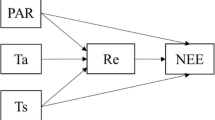Abstract
Geostatistics is a set of statistical techniques that is increasingly used to characterize spatial dependence in spatially referenced ecological data. A common feature of geostatistics is predicting values at unsampled locations from nearby samples using the kriging algorithm. Modeling spatial dependence in sampled data is necessary before kriging and is usually accomplished with the variogram and its traditional estimator. Other types of estimators, known as non-ergodic estimators, have been used in ecological applications. Non-ergodic estimators were originally suggested as a method of choice when sampled data are preferentially located and exhibit a skewed frequency distribution. Preferentially located samples can occur, for example, when areas with high values are sampled more intensely than other areas. In earlier studies the visual appearance of variograms from traditional and non-ergodic estimators were compared. Here we evaluate the estimators' relative performance in prediction. We also show algebraically that a non-ergodic version of the variogram is equivalent to the traditional variogram estimator. Simulations, designed to investigate the effects of data skewness and preferential sampling on variogram estimation and kriging, showed the traditional variogram estimator outperforms the non-ergodic estimators under these conditions. We also analyzed data on carabid beetle abundance, which exhibited large-scale spatial variability (trend) and a skewed frequency distribution. Detrending data followed by robust estimation of the residual variogram is demonstrated to be a successful alternative to the non-ergodic approach.
Similar content being viewed by others
References
Barnes, R.J. (1991) The variogram sill and sample variance. Mathematical Geology, 23, 673–8.
Cressie, N. (1985) Fitting variogram models by weighted least squares. Mathematical Geology, 17, 563–86.
Cressie, N. (1991) Statistics for Spatial Data, John Wiley and Sons, New York.
Cressie, N. and Hawkins, D.M. (1980) Robust estimation of the variogram: I. Mathematical Geology, 12, 115–26.
Cox, N.J. (1983) On the estimation of spatial autocorrelation in geomorphology. Earth Surface Processes and Landforms, 8, 89–93.
Davis, M. (1987) Production of conditional simulations via the LU decomposition of the covariance matrix. Mathematical Geology, 19, 91–8.
Deutsch, C.V. and Journel, A.G. (1992) GSLIB: Geostatistical Software Library, Oxford University Press, New York.
Greenwood, J.J.D. (1996) Basic techniques, in Ecological Census Techniques, W.J. Sutherland (ed.), Cambridge University Press, New York, pp. 11–109.
Hohn, M.E., Liebhold, A.M., and Gribko, L.S. (1993) Geostatistical model for forecasting spatial dynamics of defoliation caused by the gypsy moth (Lepidoptera: Lymantriidae). Environmental Entomology, 22, 1066–75.
Hengeveld, R. (1979) The analysis of spatial patterns of some ground beetles (col. Carrbidae), in Spatial and Temporal Analysis in Ecology, R.M. Cormack and J.K. Ord (eds), International Co-operative Publishing House.
Isaaks, E.H. and Srivastava, R.M. (1988) Spatial continuity measures for probabilistic and deterministic geostatistics. Mathematical Geology, 20, 313–41.
Isaaks, E.H. and Srivastava, R.M. (1989) An Introduction to Applied Geostatistics, Oxford University Press, New York.
Journel, A.G. and Huijbregts, C.J. (1978) Mining Geostatistics, Academic Press, New York.
Kaluzny, S.P., Vega, S.C., Cardoso, T.P., and Shelly, A.A. (1996) S + SPATIALSTATS, User's Manual, MathSoft, Seattle.
Knudsen, G.R., Schotzka, D.J., and Krag, C.R. (1994) Fungal Entomopathogen effect on numbers and spatial patterns of the Russian Wheat Aphid (Homoptera: Aphididae) on preferred and nonpreferred host plants. Environmental Entomology, 23, 1558–67.
Koenig, W.D. (1999) Spatial autocorrelation of ecological phenomena. Trends in Ecology and Evolution, 14, 22–6.
Liebhold, A.M., Elkington, J.S., Zhou, G., Hohn, M.E., Rossi, R.E., Boettner, G.H., Boettner, C.W., Burnham, C., and McManus, M.L. (1995) Regional correlation of gypsy moth (Lepidoptera: Lymantriidae) defoliation with counts of egg masses, pupae, and male moths. Environmental Entomology, 24, 193–203.
Legendre, P. and Fortin, M.J. (1989) Spatial pattern and ecological analysis. Vegetatio, 80, 107–38.
MathSoft Inc. (1995) S-PLUS User's Manual, Version 3.3 for Windows, MathSoft, Seattle.
Pannatier, Y. (1996) Variowin: Software for Spatial Data Analysis in 2D, Springer-Verlag, New York.
Raty, L., Ciornei, C., and Mihalciuc, V. (1997) Spatio-temporal geostatistical analysis of Ips typographus monitoring catches in two Romanian forest districts. In Proceedings: Integrating Cultural Tactics into the Management of Bark Beetle and Reforestation Pests, J.C. Gregoire, A.M. Liebhold, F.M. Stephen, K.R. Day, and S.M. Salmon (eds), USDA Forest Service General Technical Report (in press).
Robertson, G.P. (1987) Geostatistics in ecology: interpolating with known variance. Ecology, 68, 744–8.
Robertson, G.P., Klingensmith, K.M., Klug, M.J., Paul, E.A., Crum, J.R., and Ellis, B.G. (1997) Soil resources, microbial activity, and primary production across an agricultural ecosystem. Ecological Applications, 7, 158–70.
Rossi, M. and Posa, D. (1990) 3-D mapping of dissolved oxygen in Mar Piccolo: A case study. Enviornmental Geological Water Science, 16, 209–19.
Rossi, R.E., Mulla, D.J., and Journal, A.J. (1992) Geostatistical tools for modeling and interpreting ecological spatial dependence. Ecological Monographs, 62, 277–314.
SAS Institute Inc. (1990) SAS/STAT User's Guide, Version 6. SAS Institute, North Carolina.
Schlesinger, W.H., Raikes, J.A., Hartley, A.E., and Cross, A.F. (1996) On the spatial pattern of soil nutrients in desert ecosystems. Ecology, 77, 364–74.
Sharov, A.A., Liebhold, A.M., and Roberts, E.A. (1997) Methods for monitoring the spread of gypsy moth (Lepidoptera: Lymantriidae) populations in North America. Journal of Economic Entomology (in press).
Smith, D.R., Conroy, M.J., and Brakhage, D.H. (1995) Efficiency of adaptive cluster sampling for estimating density of wintering waterfowl. Biometrics, 51, 777–88.
Southwood, T.R.E. (1978) Ecological Methods, Chapman and Hall, London.
Srivastava, R.M. and Parker, H.M. (1989) Robust measures of spatial continuity, in Geostatistics, Volume 1, M. Armstrong (ed.), Kluwer Academic Publishers, Boston, pp. 295–308.
Starks, T.H. and Fang, J.H. (1982) The effect of drift on the experimental semivariogram. Mathematical Geology, 14, 309–20.
Thompson, S.K. (1990) Adaptive cluster sampling. Journal of the American Statistical Association, 85, 1050–9.
Thompson, S.K., Ramsey, F.L., and Seber, G.A.F. (1992) An adaptive procedure for sampling animal populations. Biometrics, 48, 1195–9.
Author information
Authors and Affiliations
Rights and permissions
About this article
Cite this article
Curriero, F.C., Hohn, M.E., Liebhold, A.M. et al. A statistical evaluation of non-ergodic variogram estimators . Environmental and Ecological Statistics 9, 89–110 (2002). https://doi.org/10.1023/A:1013771109591
Issue Date:
DOI: https://doi.org/10.1023/A:1013771109591




